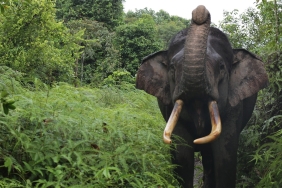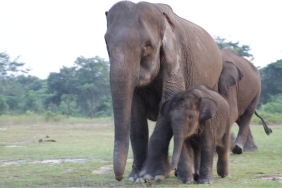DEFENDING THE NATION'S ENDANGERED TREASURES: THE SUMATRAN ELEPHANT
By: Hijrah Nasir
.
having a smart brain I should be able to
when another elephant falls, help
your body there must be willing to be my guest
Still remember the fragment of the Tulus song above. This elephant-inspired song is only one of many works that tell about the philosophy of elephants.
Elephants, which are the largest land mammals in the world, have always been symbolized as large and strong animals, with wide ears, strong and large legs, small eyes, trunks and tusks. Elephants have always been used as a symbol of intelligence, loyalty, leadership and discipline. It is even rumored that an elephant helped humans during the 2004 tsunami in Thailand.
But did you know that elephants, which are always symbolized by good things, are now endangered? There are two types of elephants in the world, the Asian Elephant and the African Elephant. The Asian Elephant has several subspecies including the Indian Elephant (Elephas maximus indicus), Sri Lanka Elephant (Elephas maximus maximus), Sumatran Elephant (Elephas maximus sumatranus), Kalimantan Elephant (Elephas maximus borneensis), and the African Elephant which has 2 subspecies, the African Savannah Elephant (Loxodonta africana africana), and the African Forest Elephant (Loxodonta africana cyclotis).
Indonesia's two elephant subspecies are categorized as critically endangered. That means their status is one step before being declared extinct in nature. Elephants have a huge role in maintaining the balance of the forest ecosystem. Sumatran elephants, for example. This elephant has a range (homerange) of 170 km2 per day. One adult elephant can consume about 136 kg/day of food. This means that with the amount of space it travels every day, it will spread seeds naturally, thus improving the condition of the forest. Its dung can also be a natural fertilizer for plants.
Elephant, a forest nurse whose existence is now increasingly depressed. Habitat degradation and fragmentation have caused them to lose their natural habitat for food, often triggering conflicts with humans. These conflicts often result in casualties on the elephant's side. They are often chased away and even killed because they are considered pests. To make matters worse, poaching and trade in elephant body parts is still rampant.
[Read also: Mahout, the Elephant Partner of Elephant Flying Squad Patrol Team]
In 25 years, Sumatran elephants have lost about 70% of their habitat, and their population has shrunk by more than half. The estimated population in 2007 was between 2,400-2,800 individuals, but it is now estimated to have fallen far short of this figure as habitat continues to shrink and killing continues. In addition, another problem is the distribution position of the Sumatran elephant which is not only in conservation areas, even 90% of its habitat is in company concessions or community development in many places. This further triggers the emergence of human-elephant conflicts.
The ancient mammal that is the pride of Lampung is now only left in a few pockets in Lampung. The rampant poaching of these animals has triggered a significant population decline. Elephant deaths as a result of poaching are sometimes still found by TNBBS and TNWK officers and NGO partners in the TNBBS area. Weak law enforcement against suspects of elephant poaching and trade is a sharp stone that hampers efforts to protect Sumatran elephants.
WWF Indonesia's report states that less than a decade ago 129 elephants were killed in Sumatra, especially in Riau province. As many as 59% of their deaths were due to poisoning, 13% were suspected of being poisoned, and another 5% were killed using firearms.
One famous phrase came from Graydon Carter, a famous Canadian journalist;
"We admire elephants in part because they demonstrate what we consider the finest human traits: empathy, self-awareness, and social intelligence. But the way we treat them puts on display the very worst of human behavior."
Elephants are close to the culture of Indonesian society, especially for the people of Sumatra where pockets of Sumatran elephant habitat are located. But how some of us treat elephants sometimes does not show respect. Elephants are only seen as cute animals that often become a spectacle, even a media for political campaigns. Not infrequently their existence is considered a pest for farmers. In fact, elephants are animals that play a major role in balancing the forest ecosystem so that humans can benefit greatly from their existence. Protecting elephants is the same as protecting our own lives. But have we ever thought about the fate of elephants?





